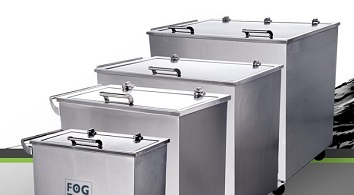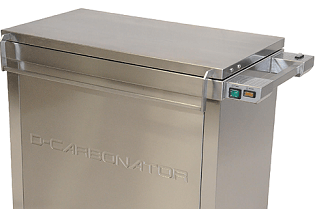
NATIONAL REPORT—In any discussion about sustainability, it is likely that carbon will enter the discussion at one point or another. In any conversation about sustainability in the kitchen, carbon also has a place, but in more ways than one. It is not only the carbon emissions from running the lighting, appliances and HVAC system, it is the actual carbon buildup on pots, pans and other items. This buildup is a barrier to heat, which means it can take longer for items to cook or bake. The longer ovens or stoves run, the higher the energy bill and related environmental impact. Carbon buildup can also impact the quality of the product cooked or baked and can be a home for bacteria. Fortunately, at least two suppliers, both of whom exhibited at last month’s NAFEM Show in Orlando, offer heated soak tanks that eliminate carbon buildup as well as FOG (fats, oils and grease).
The FOG Tank from Hyginix LLC removes buildup from metal cookware and kitchen and bakery equipment. It is constructed from 304 grade stainless steel, is fully insulated, and cleans all types of metal, including aluminum. According to Craig Gavson, CEO of Hyginix, the FOG Tank comes in four different sizes—25 gallons, 40 gallons, 80 gallons, and 120 gallons. “We also offer custom sizes for larger applications,” Gavson says. “We can make a 250-gallon tank, a 500-gallon tank.” Manual or automated hoists can be purchased for larger machines.
Gavson says the FOG Tank eliminates a lot of the labor, energy, water and chemicals associated with cleaning pots, pans, vent hood filters and other kitchen equipment. Users of the FOG Tank simply fill it with water, add Tiger Carbon Remover Powder, load the tank with the dirty items, close the lid and leave the items to soak. The final step is removing and rinsing the items.
An Inefficient Sink Process
Those not using a heated soak tank typically rely on a three-compartment sink for cleaning dirty pots and pans and other items. Removing caked on grease and carbon this way can be labor intensive, aggravating to employees, and ergonomically impactful over time. Chemicals used also can be harmful. “You are typically using large quantities of water, sanitizer, and detergent,” Gavson says. Water costs are significant because water needs to be replaced three to eight times a day. That water needs to be heated. Sanitizer and detergent also need to be replaced often. Also, scrubbing the items can reduce their life expectancy.
Using a heated soak tank, water can be used for days at a time and the solution in the tank can last for a full month. Gavson says the FOG Tank operates at 185 degrees. Because it is well insulated, the machine’s heater runs just one hour out of 24. A thermostat controls the heater. The 40-gallon FOG Tank uses a 1kW heater. The items in the tank sit within another tank.
Gavson says there was a time when soak tanks used cold water and a harsh chemical for cleaning. That chemical was hazardous to the operator and the items being cleaned. The chemical could eat holes in the items. Cleaning in cold water also took a long time. Today’s heated soak tanks are much more efficient and able to do a lot of the functions of the sink and warewashers but more efficiently and at a much cheaper cost.
Heated soak tanks are built to sit under the three-compartment sink. What is removed in the cleaning process either floats on the surface or drops down as heavier sludge. There are perforations in the lifting basket—the tank within the tank—that allow the sludge to fall to the bottom of the tank. At the end of each month, the heat is turned off, the tank is drained using the floor drain, and the debris is removed.
Soak tanks were originally designed for the cleaning of hood filters that collect FOG. The baffles within the filters trap the FOG. It is imperative for the FOG to be removed regularly in order to prevent hood fires.
Heated Soak Tanks from ChemxWorks

Like the FOG Tank, the DE-CARBONATOR from ChemxWorks Inc. comes in different sizes—six to be exact. The D-CARBONATOR is fully insulated and thermostatically controlled. Once the appliance reaches a temperature of 185 degrees, the heater will switch off. It will remain off until the temperate drops gradually and then switch on again when it reaches the low set point. While the heater is off, virtually no electricity is being used. The heater remains off 75 percent to 80 percent of the time. The DE-CARBONATOR uses CarbonZyme. It lasts for a month at a time. At the end of the monthly cycle, the Refill Indicator will change from green to red. This indicates that the monthly refill of CarbonZyme is due.
According to ChemxWorks, hood filters cleaned using the DE-CARBONATOR help to keep kitchens cooler. Efficient filters also reduce strain on HVAC motors.
Tests conducted by ChemxWorks found the total DE-CARBONATOR cost to be less than $10 per day as compared to about $80 for a three-compartment sink and $350 for a dish machine.
When asked what one should look at when considering heated soak tanks, Hyginix LLC’s Gavson says to get an understanding of the volume of filters and other items that need to be cleaned. Space for the machine is a consideration. Also look for the UL logo. It is the “gold standard,” Gavson says. “The insulation and quality of construction is also important.” Hyginix LLC gives its customers the option of purchasing or leasing its soak tanks. A risk-free trial is also available.
According to Gavson, in recent years heated soak tanks have become much better known. “We have reached a tipping point,” he says. “You are helping the planet and helping people be safer.”
Glenn Hasek can be reached at editor@greenlodgingnews.com.






